
Inspirations
Explore the elevated life in the mountains. This content debuted in 2015 with Alpine Modern’s printed quarterly magazine project.
A Winter’s Feast
Alpine Modern gathers a circle of friends and coworkers around the table in a chef’s beautiful Colorado home to celebrate life, food, and fellowship in the season of winter feasting.
The season of winter feasting creates a cornucopia of holidays: Thanksgiving, Hanukkah, Christmas, the Winter Solstice, Kwanzaa, the New Year, plus birthdays and anniversaries. These celebrations inspire us to gather friends and family together for a memorable meal. But these days, with our busy lives and family and friends often flung to the far corners of the world, getting a dozen people around your table for a dinner party can present a challenge—along with a measure of intimidation.
Menu planning, creating or finding the right recipes and foods, setting a beautiful table, cooking and timing the courses all require considerable skill and energy. Additionally, there’s a feeling of vulnerability—having people in your house, seeing how you live. Entertaining and orchestrating a special meal takes the host through the whole gamut of human emotions.

Flavors of entertaining
Entertaining has many faces. It can be simple, like soup and bread, or a sumptuous banquet. It can be planned months in advance or spontaneous and spur of the moment. There are as many styles of entertaining and hosting as there are personalities.
And that’s what creates the individual flavor and enjoyment of it—visiting someone’s unique home and seeing how they live, along with the types of food they like, their décor, artwork, and lifestyle. The best meals and get-togethers focus on togetherness rather than technique or perfection. Having guests help with some of the preparation sets the tone—even if it’s minimal like slicing the bread, tossing the salad, or helping to set the table.


The very human act of gathering
What is the true meaning of gathering and entertaining, really? Again, there are as many reasons and styles as there are days in the year.
Gathering to celebrate special occasions, birthdays, holidays, family, and community rituals may prompt us to investigate the practical, traditional, philosophic, spiritual—and perhaps even mystical—nature of entertaining and hospitality. What are some of the deeper primal undertones of this very human act of gathering together?
Dongzhi, or the Chinese Winter Solstice Festival, celebrates the coming of the cold weather and the return of the sun with feasting and festivities. Originating with the Han Dynasty (206 B.C.–A.D. 220), the Winter Festival pays homage to the ancient yin and yang philosophy of balance and harmony in the cosmos. The philosophy holds that the yang, or muscular, positive energy, increases daily after the shortest day—so should be celebrated. Family get-togethers involve the making and eating of tangyuan, a sweet soup with balls of sticky rice, which symbolizes reunion.
Worldwide, changing seasons—the arrival of spring, midsummer, the autumn harvest, and especially the winter solstice—have historically been special times to celebrate and feast. Humankind has venerated the return of the sun’s light at the winter solstice throughout history and prehistory. Feasts have been held, and monuments have been painstakingly constructed and dedicated to it.


On a chilly night, we gathered for a winter feast that Colin and Sarah Kirby graciously hosted at their modern Boulder, Colorado, home to celebrate good food, camaraderie, and hospitality. According to Chef Colin, hospitality at its simplest is taking care of people, treating people well. The flavor of a host’s hospitality conveys a certain way of looking at the world, through food, drink, and its presentation.
"The flavor of a host’s hospitality conveys a certain way of looking at the world, through food, drink, and its presentation."

Perfect moments to remember
What happens when it all comes together? That moment when it all works really well? Reunion—as with the Chinese Dongzhi celebration. Communion. The creative and thoughtfully prepared meal is an emotional and spiritual experience. In addition to enjoying delicious food, guests feel a warm and deep appreciation for the host’s labors and generosity, and for each other. It’s truly a celebration and labor of love.
Some people, like our host, specifically design their homes with entertaining in mind. Colin’s cleverly repurposed and beautifully refinished Douglas fir floor joists–turned–dining table perfectly seats a dozen guests, as he intended. Set alongside an open kitchen, the broad table invites participation and observation.
As our host chef concludes, “Cooking is the only art form that engages all five senses.” And like any art form, an exquisitely conceived and executed meal inspires, elevates, educates, and enlivens.
In addition to the shared ritual of emotional and physical nourishment and sustenance, a special dinner or feast also offers the chance to learn about new foods and recipes, perhaps the favorites of the host. Special recipes from family or friends carry memories and significance, and enrich the experience of others who replicate them.
“Cooking is the only art form that engages all five senses.”

Recipes can hold special meanings for people, especially when passed down through generations or created for a unique event. Here, we are sharing some recipes our host, Colin Kirby, served at Alpine Modern’s Winter Feast that we hope will inspire you to take up the wooden spoon, start cooking, and gather some hungry souls around your table in celebration of togetherness. △
Recipes for a winter's feast
Tomato-Braised Leg of Lamb
The headliner. Braised in the oven for hours before your guests arrive, making this lamb dish will fill the house with a savory fragrance that will draw everyone into the kitchen. Go to recipe »
Braised Leeks with Black Truffle
An elegantly simple vegetable side for any festive dinner. Go to recipe »
The Alpine Glissade
Luscious Holiday libation: A festive cocktail based on cold-drip coffee. Go to recipe »
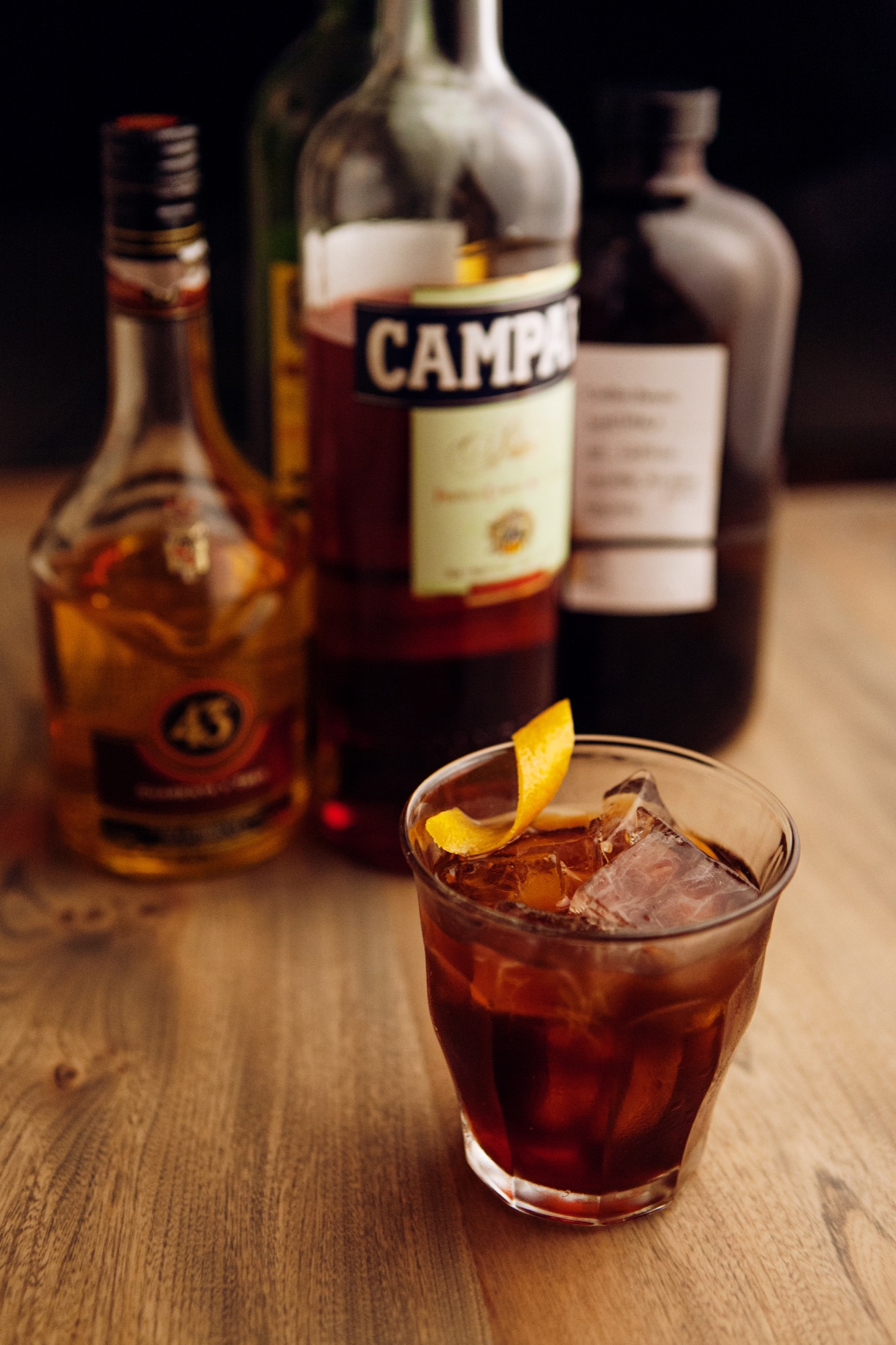
Recipe: Braised Leeks with Black Truffle
An elegantly simple vegetable side for any festive dinner
INGREDIENTS
leeks: 12 small, cleaned and trimmed black truffle butter: 8–10 oz (227 to 283 g) *or regular butter with high-fat content salt pepper red radish: 1
DIRECTIONS
Bring a large pot of salted water to a boil. Also, prepare an ice bath. Remove the root end of the leek and trim the green leaves so roughly 6 inches (15 cm) of the leek is available. Then, cut in half lengthwise. Set aside. Place the leeks into the blanching water for approximately 6 minutes or until nearly tender. Remove from pot and place in the ice bath until cool to stop the cooking process.
In a large sauté pan on medium, heat a small amount of grape seed oil and gently arrange the cooked leeks so they fit in one layer. Once the leeks are hot and begin to sear slightly, place a piece of circular parchment paper on top of the leeks to help them cook evenly (see photo). Add the black truffle butter. Once the butter is melted, season with salt and pepper and serve, on the table, out of the sauté pan. Shave the red radish on a microplane and top the cooked leeks with it for added texture. Serves 10. △
This recipe is part of Alpine Modern's big Winter Feast, which we will publish here this week.
Recipe: Muscovy Duck Breast with Chanterelles, Pickled Radish, and Foie Gras Gastrique
A fine duck dish starring mushrooms and pickled garden gems preserved from summer
INGREDIENTS muscovy duck breasts: 2 breasts salt pepper grapeseed oil chanterelles: 113 g (4 oz) shallot: 1, diced butter: 28 g (2 T) thyme: 3 sprigs
GASTRIQUE
reserved apple liquid: 236 ml (1 cup) from Whiskey Preserved Apples recipe shallot: ½, diced bay leaf black peppercorns apple cider vinegar: 118 ml ( cup) rendered foie gras fat: 30 ml (2 T)
Duck Breast
Preheat oven to 180° C (350° F). Carefully score the skin with a sharp knife. Season tempered duck breast generously with salt and pepper. On medium-high heat, heat grapeseed oil until the oil is hot. Sear, skin-side down, until skin is nicely golden brown. Place pan (with the duck in it) in the oven until the duck breast reaches 54.4° C (130° F). Remove duck from the pan, let it temper for a few minutes before slicing. Finish sliced breast with sea salt and set aside.

Chanterelles
Carefully clean the mushrooms to remove excess dirt. Once clean, heat a pan, add a small amount of grapeseed oil, and add diced shallot. Once the shallot is translucent, add the mushrooms, season with salt and pepper, and cook for 3–5 minutes. Add a knob of butter and a few sprigs of thyme. Once butter is melted and mushrooms are coated, remove from pan and set aside.
Gastrique
Remove half of the liquid from the cooked apples (see recipe). Place in a saute pan with diced shallot, bay leaf, and black peppercorns. Reduce liquid by half, add apple cider vinegar. Reduce the liquid another quarter (total time 8‒10 minutes). Strain and return to cleaned sauté pan. Add a tablespoon of rendered foie gras fat for flavor. Season with salt and pepper. Stir and set aside.

Pickled Radish
See recipe for Red Wine Pickling Liquid. Set aside 3‒5 wedges.
To serve
Place the sliced duck, chanterelles, and pickled vegetables on a plate and pour the gastrique on top. Serves two.
Other garnishes include
Pickled gooseberry, green strawberries, pickled cherries. It’s easy to substitute any of these as need be. △

This recipe accompanies "Preserving Traditions."
Recipe: The Alpinist's Larder
A preserved whiskey drink spiked with the taste of the summer passed
INGREDIENTS
pickled cherries: 3 pieces preserved whiskey: 60 ml (2 oz) leopold bros. three pins herbal liquor: 20 ml (0.7 oz) lemon juice: 20 ml (0.7 oz) honey syrup: 20 ml (0.7 oz)
DIRECTIONS
1 Combine all ingredients into a shaker 2 Gently muddle the cherries 3 Shake with ice 4 Double strain over ice 5 Garnish with cherries, mint, and lemon peel.

Recipe: Alpine Hot Toddy
Enjoy a warming drink in memory of the summer harvest
INGREDIENTS herb bundle: Thyme, marjoram, sage, lemon peel, mint, sorrel whiskey preserved apples: 30 g (1 oz), diced violet flowers preserved whiskey: 60 ml (2 oz) leopold bros. three pins herbal liquor: 20 ml (0.7 oz) lemon juice: 20 ml (0.7 oz) hot water: 1 pitcher
DIRECTIONS
1 Place all ingredients into a heat-resistant pitcher 2 Add hot water to steep (1‒2 minutes) 3 Strain into a heated mug or glass 4 Garnish with apples and lemon peel.
 Photo by Ashton Ray Hansen
Photo by Ashton Ray Hansen
 Boulder bartender Jon Watsky making the Alpine Hot Toddy / Photo by Ashton Ray Hansen
Boulder bartender Jon Watsky making the Alpine Hot Toddy / Photo by Ashton Ray Hansen

This recipe accompanies "Preserving Traditions."
Recipe: Whiskey Preserved Apples
Bag summer for a little while longer. Winter is coming.
INGREDIENTS Honeycrisp or Gala Apples: 2 peeled, quartered, and cored Rye or Bourbon whiskey: 300 ml (10 oz) Honey syrup: 60 ml (2 oz)—1:1 ratio honey:water Thyme: 1 sprig Sage: 1 sprig Lemon Peel: 2 peels Orange Peel: 2 peels Fennel Seed: 3 g (⅔ tsp, 0.1 oz) Clove: 3 g (⅔ tsp, 0.1 oz) Cinnamon Stick: 1 small
DIRECTIONS
1 Blanch (for 2–3 minutes) and shock the apple quarters. 2 Place all contents into a cryovac bag and seal. 3 Using an immersion circulator, poach the contents for 3 hours at 48° C (118° F). 4 Save liquid for the Alpine Hot Toddy recipe.
This recipe accompanies "Preserving Traditions."
Preserving Traditions
Savor harvest flavors well into winter by preserving the simple traditions and the sweetest fruits of alpine summer.
Preserving fresh foods so they will provide lasting sustenance through the cold season has been the stuff of daily life since the beginnings of human civilization—nowhere more so than in the mountains and other places where winter lingers.

Cured, dried, smoked, and salted meats and fish. Buttermilk, kefir, and cheese from fresh milk. Wine, spirits, beer, and cider. Pickles, krauts, jams. Tea, coffee, and kombucha. Many of our favorite foods and drinks are created through preservation and fermentation.
Cultured heritage
Passed down through generations, these basic methods served as important tools for surviving lean times. They also served, and can still serve, as familiar rituals that weave and strengthen family and community ties—and enliven our palates, hearths, and communal tables.
Your grandmother may have canned, but with the industrialization of food in the past half-century, many of us have lost touch with this inherited knowledge. Today, people around the world are paying more attention to what they eat and where it came from, tuning in to seasonal foods grown where they live, and reclaiming the simple labors and rewards of growing, preparing, and preserving some of their own food.
Sour beers, probiotic-rich fermented foods, and artisan pickles and preserves are now mainstays at craft breweries, farm-to-table eateries, even grocery stores. In many ways, it’s the rebirth of a more handcrafted, gastronomically rich world, one you can share with your family and generations to come.
"In many ways, it’s the rebirth of a more handcrafted, gastronomically rich world, one you can share with your family and generations to come."
Craft, quality, and connection
Everyone is evidently busier than ever these days. So why this nostalgic look backward at earlier ways of life and at “slow-food” traditions? Amidst the rush, we intuit the importance of slowing down every once in a while to can, pickle, or bake a pie... or to savor a nice bottle of wine or a great cup of coffee. It’s the only way we actually live in the moment. Instant gratification is rarely authentic and ultimately without value.

Preserving basic foods is often done when there’s a surplus of a food: peak season or a bumper harvest. Gathering in a kitchen with a group of people committed to one project, like jarring ramps or canning tomatoes, is a good source of inspiration. Making your own food and creating foods you can’t easily find elsewhere creates a potent connection. People will always gravitate toward craft and quality.
"Making your own food and creating foods you can’t easily find elsewhere creates a potent connection."

Flavor alchemy
Preserved foods are transformed through alchemical processes that yield bright, distilled flavors that shift, soften, and deepen over time. They are living, breathing things. You never know exactly what you’ll get when you open the jar or the bottle.
"[Preserved foods] are living, breathing things. You never know exactly what you’ll get when you open the jar or the bottle."
Food pros like Boulder-based Chef Colin Kirby (El Bulli, Spain, 2008) know a secret: Preserving makes foods more interesting. Done right, simple methods add new life to the most basic ingredients. For instance, savory fruits pickled with varied vinegars make inspiring elements of a complex dish. The key? They create a balance between fat and acidity, a too-often-forgotten flavor component.
Here, the minimalist chef introduces a few techniques:

White Balsamic Pickling Liquid
INGREDIENTS white balsamic vinegar: 2 parts sugar: 1 part salt: 1 part
DIRECTIONS Heat all ingredients to 82° C (180° F) or higher to dissolve sugar. Let cool and set aside
Red Wine Pickling Liquid
(for Cherries and Radishes)
INGREDIENTS red wine vinegar: 1152 g (38 oz) water: 535 g (19 oz) sugar: 254 g (9 oz) peppercorn bay leaf
DIRECTIONS Heat all ingredients to 82° C (180° F) or higher to dissolve sugar. Let cool and set aside
Apple Cider Pickling Liquid
INGREDIENTS apple cider vinegar: 2 parts sugar: 1 part salt: 1 part
DIRECTIONS Heat all ingredients to 82° C (180° F) or higher to dissolve sugar. Let cool and set aside
Rice Wine Brine
(for Green Strawberries and Gooseberries)
INGREDIENTS rice wine vinegar: 340 g (12 oz) sugar: 340 g (12 oz) water: 200 g (7 oz) lime juice: 90 g (3 oz) bay leaf mustard seed peppercorn
DIRECTIONS Heat all ingredients to 82° C (180° F) or higher until sugar is dissolved. Let cool and set aside.
A note on processing, storage, and safety
The vinegar and spices in these recipes make all the difference. They give fruit and vegetables new life and provide inspiration to any chef. Pickling unique ingredients such as green strawberries and gooseberries gives great acidity and texture to classic dishes like duck and chanterelles.
The vinegar also allows for processing (boiling and sealing the jars to prevent spoilage) to occur, and it ensures the pH is below 4.6. This is very important. When any of these recipes are used for long-term storage, please follow basic canning rules: Sterilize jars and lids, test the pH (general rule is below 4.6), and carefully boil the jars before setting aside. Once these rules are followed, start canning. △
Recipe: Muscovy Duck Breast with Chanterelles, Pickled Radish, and Foie Gras Gastrique
A fine duck dish starring mushrooms and pickled garden gems preserved from summer. Go to recipe »
Recipe: Whiskey Preserved Apples
Bag summer a little while longer. Go to recipe »
Recipe: Alpine Hot Toddy
Enjoy a warming drink in memory of the summer harvest. Go to recipe »
Recipe: The Alpinist's Larder
A preserved whiskey drink spiked with the taste of the summer passed. Go to recipe »
Go Wild
Wilderness to table: Serve what nature offers where you are
Forage the forest floor, fish the mountain creek, and relearn respect for nature’s abundant gift of authentic ingredients. Following in the footsteps of culinary ground-breakers like Chef René Redzepi (Noma, Copenhagen, Denmark) and Chef Magnus Nilsson (Fäviken, Åre, Sweden), Alpine Modern wanders into the woods . . . where the wild things are.
The wilderness-to-table movement is the antithesis of getting any product from anywhere in the world anytime, in season or not. Hunting and gathering for your meal du jour takes advantage of what grows or lives in the place where you are, at the time an ingredient is ripe and ready. The food you eat is your connection to the present and to where you are in the world.
"The food you eat is your connection to the present and to where you are in the world."
Elevated Localism
Foraged food takes the concept of eating local yet further. All around the world, entire restaurants are now based on the principle of serving what nature offers right outside the door — the menu written by place and time. Chef René Redzepi at restaurant Noma in Copenhagen, Denmark, is conceivably the progenitor of a culinary counterculture that looks to the local landscape to rediscover an innately authentic fine cuisine, made from what is.
Seasons once again have significance. So, what to serve during the winter months, if FedExing in- gredients from halfway around the world conflicts with your food philosophy? Our ancestors’ preser- vation methods—pickling, jarring, canning, curing, kippering—have dwindled to all but forgotten skills. Magnus Nilsson, head chef of Fäviken Magasinet restaurant in Northern Sweden and au- thor of the complementing cookbook Fäviken, is a master curator of these past techniques, carefully maintaining the traditions like a dying language.
"Seasons once again have significance."
A Dish, Discovered
Recipes and shopping lists are needless in foraging for nature’s edible glory, since searching the forest for a particular wild vegetable could prove a foolish attempt. Look around instead, mind wide open. Awareness comes before inspiration.
"Recipes and shopping lists are needless in foraging for nature’s edible glory, since searching the forest for a particular wild vegetable could prove a foolish attempt."
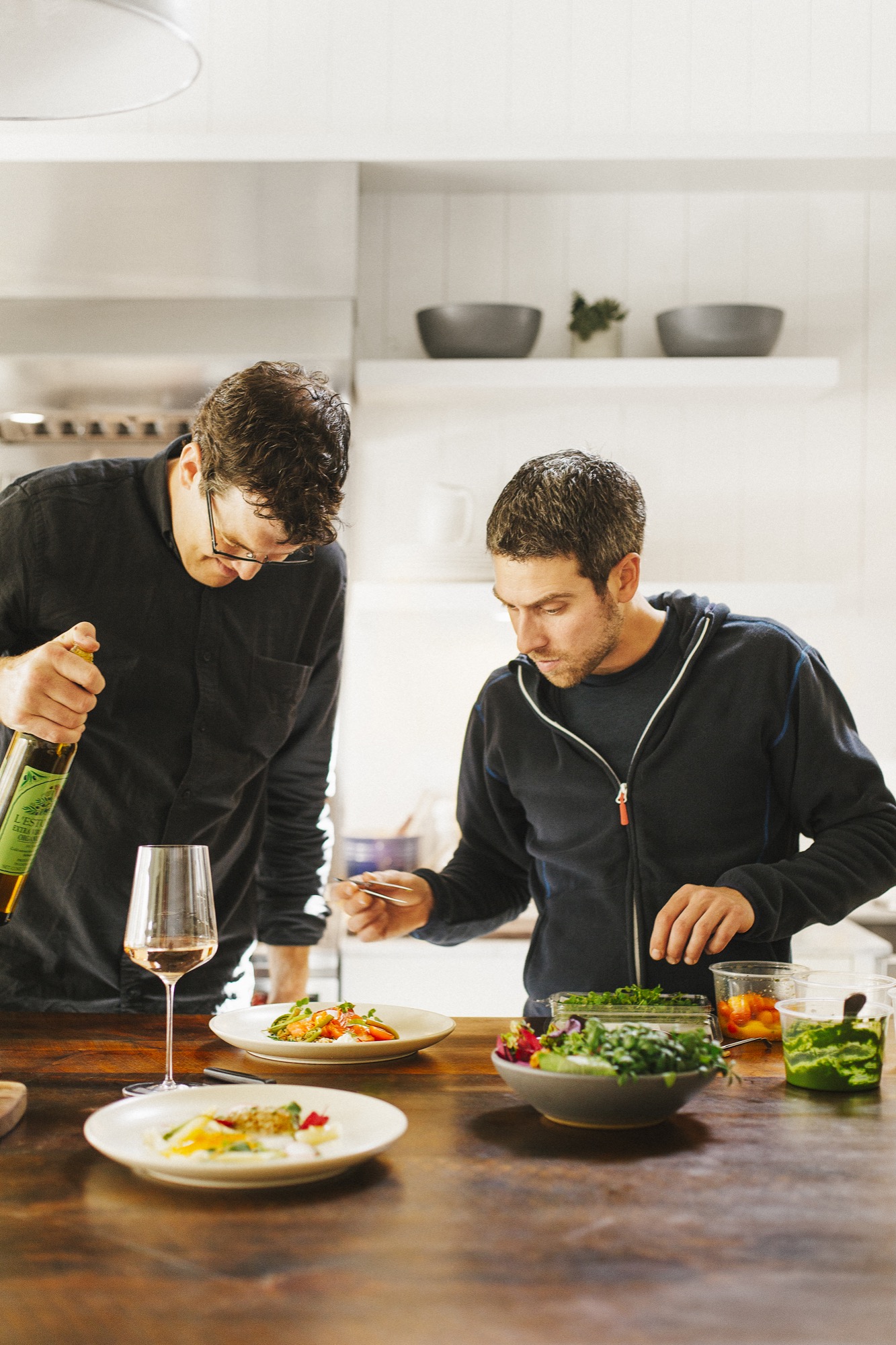
Granted, rambling meadows, curious what you may cook, can be daunting, whether you’re expecting friends over or feeding your über-exclusive restaurant’s patrons. The unknown, the serendipity, the exploratory idea of discovering, aha, it’s porcini for dinner, become part of the adventure. What’s more, wild ingredients will vary widely, and you may not find perfect bunches of white asparagus under a spruce tree. Nevertheless, anytime you pull an ingredient out of the ground or catch it from the creek, you are going to respect its more distinct, more identifiable flavor the more for it.
Alpine Modern’s resident culinary mastermind, Colin Kirby (El Bulli, Spain, 2008), knows to step out of the way of fresh, pure ingredients. If life deals him morels, he lets them shine by applying minimal technique.
Here, the mindful chef curates a spread of dishes and drinks that taste of the here and now. Go wild with him. △
Wilderness-to-table recipes
White Asparagus and Morel Salad
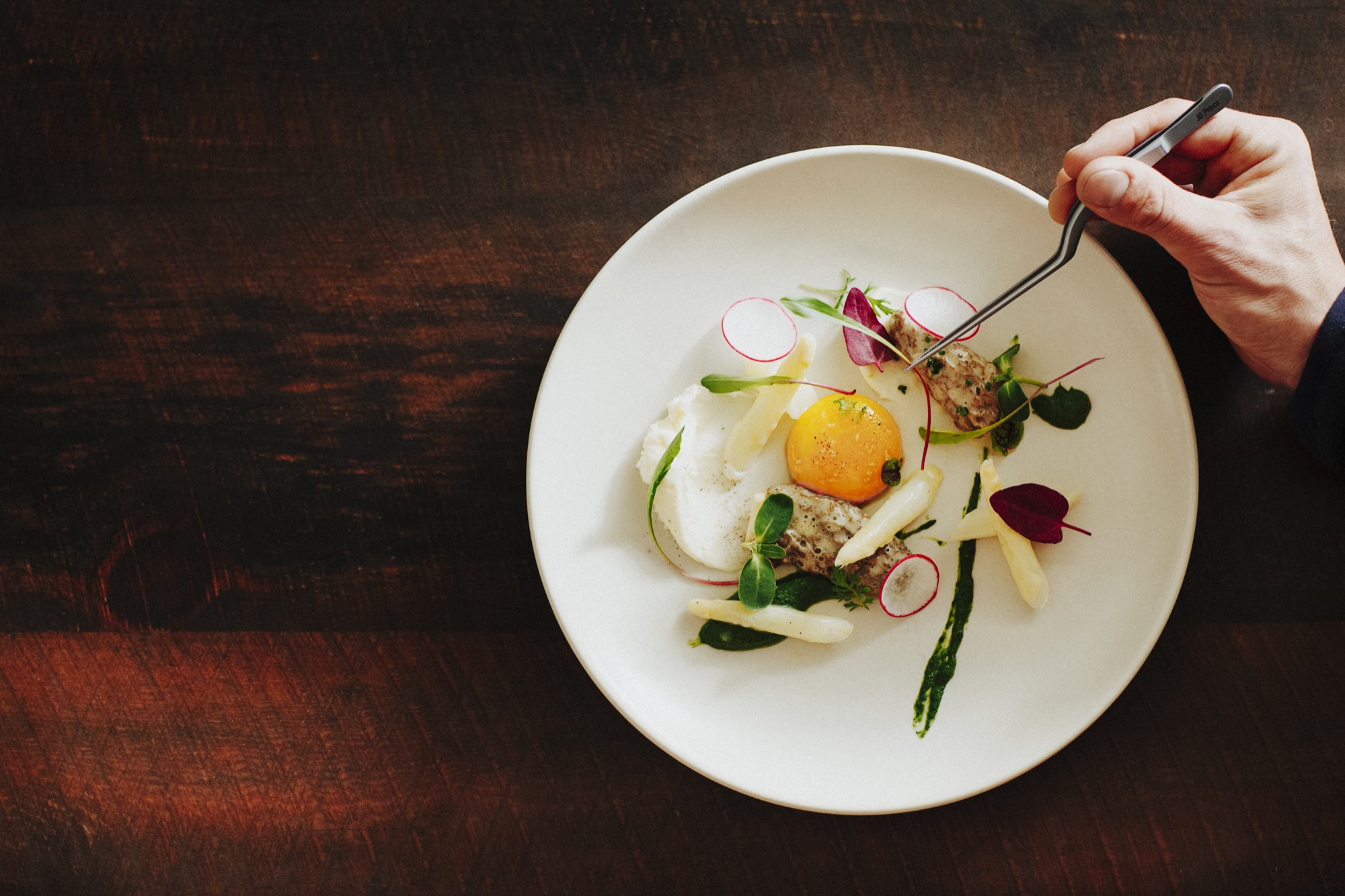
A delicate side dish with morels poached in beurre monte, asparagus and egg on ramp top puree. Recipe »
Smoked Trout Salad
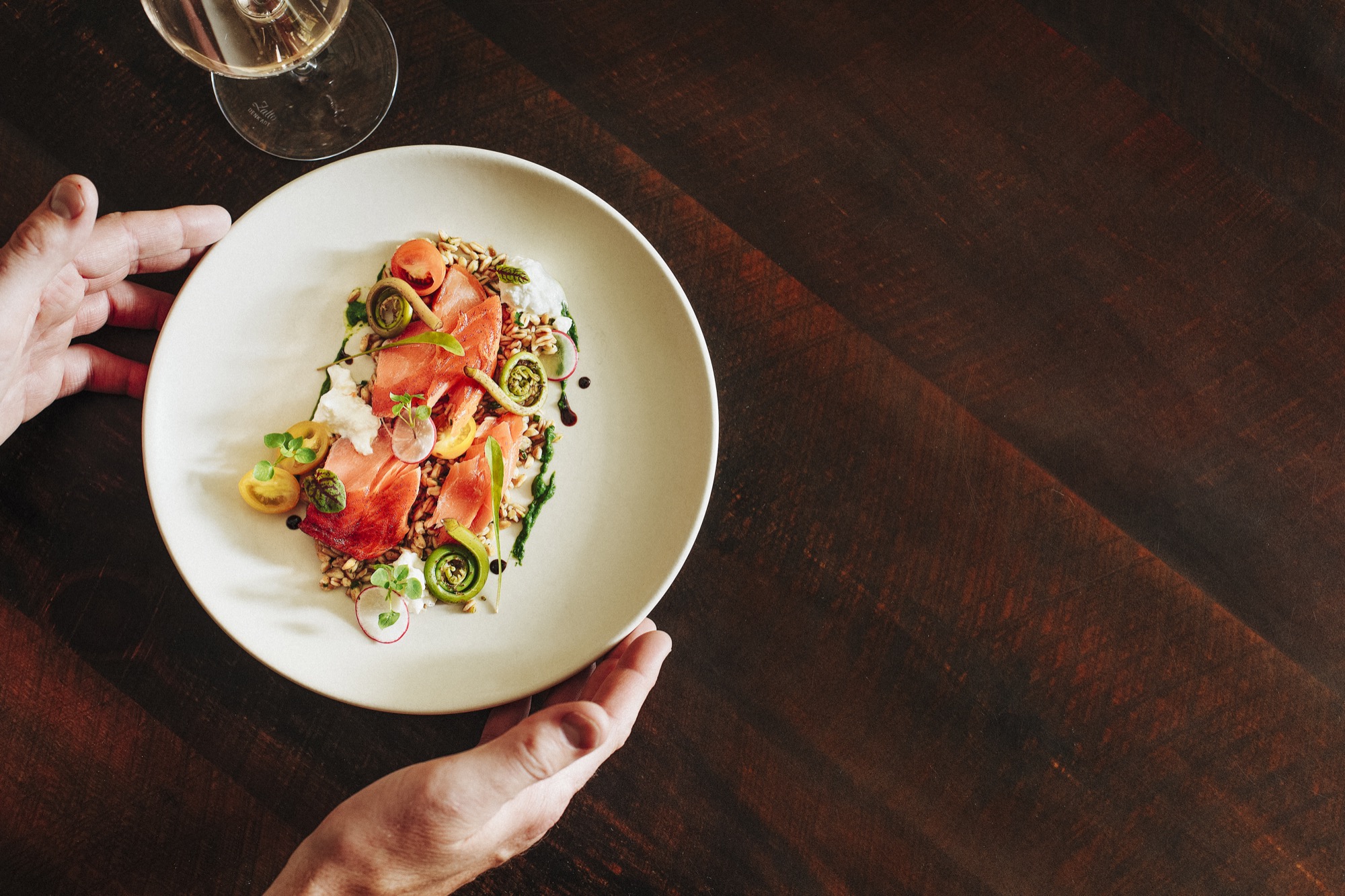
A wild and fresh dish with your smoked catch and fiddlehead ferns with its great woodsy, almost bitter flavor reminiscent of the forest floor. Recipe »
Alpine Fizz
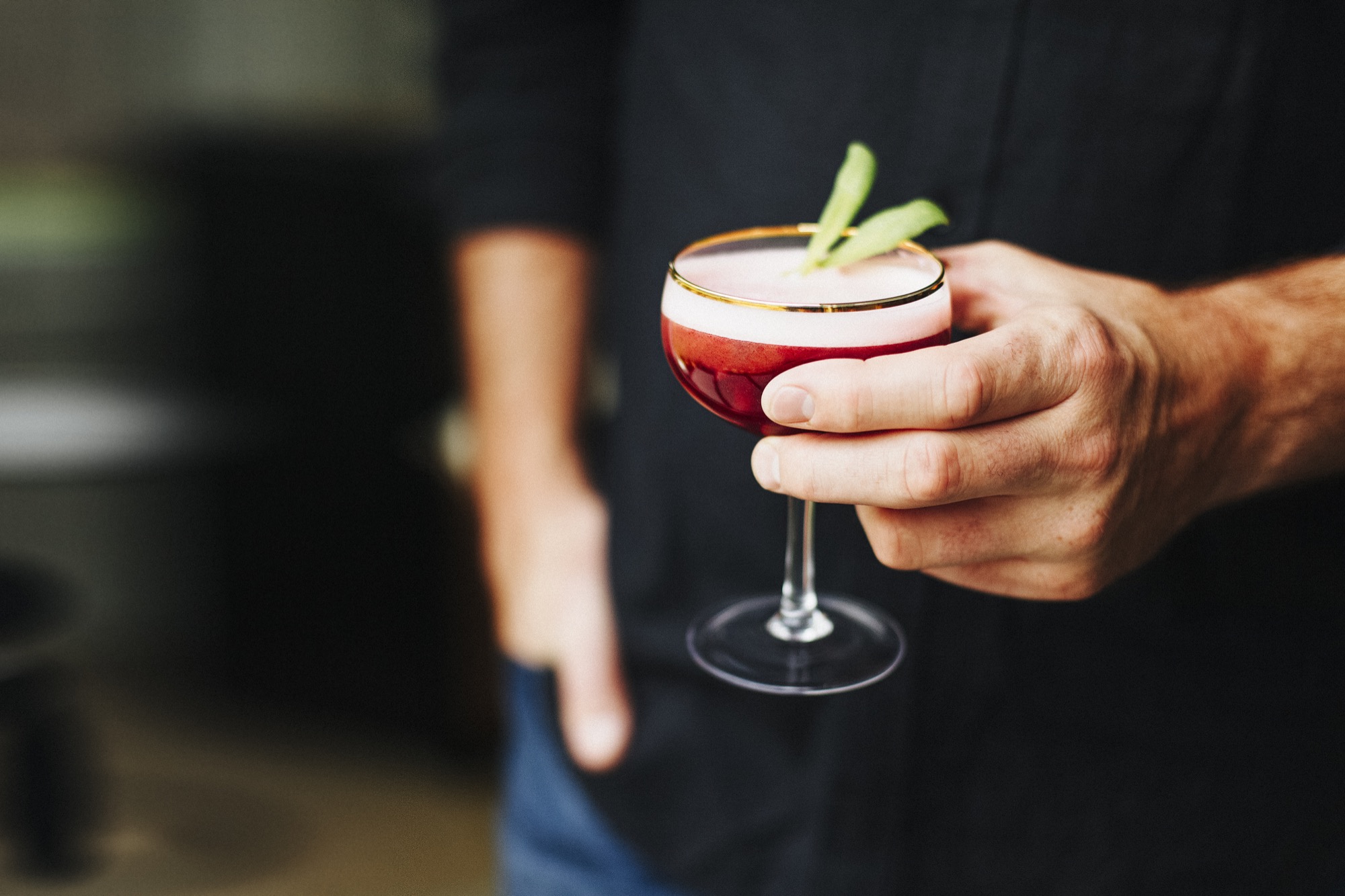
A fizzy gin cocktail with homemade huckleberry-sage syrup. Recipe »
Recipe: White Asparagus and Morel Salad
A delicate side dish with morels poached in beurre monte
Ingredients
- 6 white asparagus
- 6 morels (cleaned)
- 2 radishes
- 1 bunch ramp tops
- 1 egg yolk
- 1 shallot
- 2 pounds (907 grams) butter (cubed)
- 1 tablespoon (15 milliliters) water (for beurre monte)
- 4 ounces (113.3 grams) Delice de Bourgogne cheese
- Dandelion greens
- Sheep sorrel
- Red orach
- Purslane
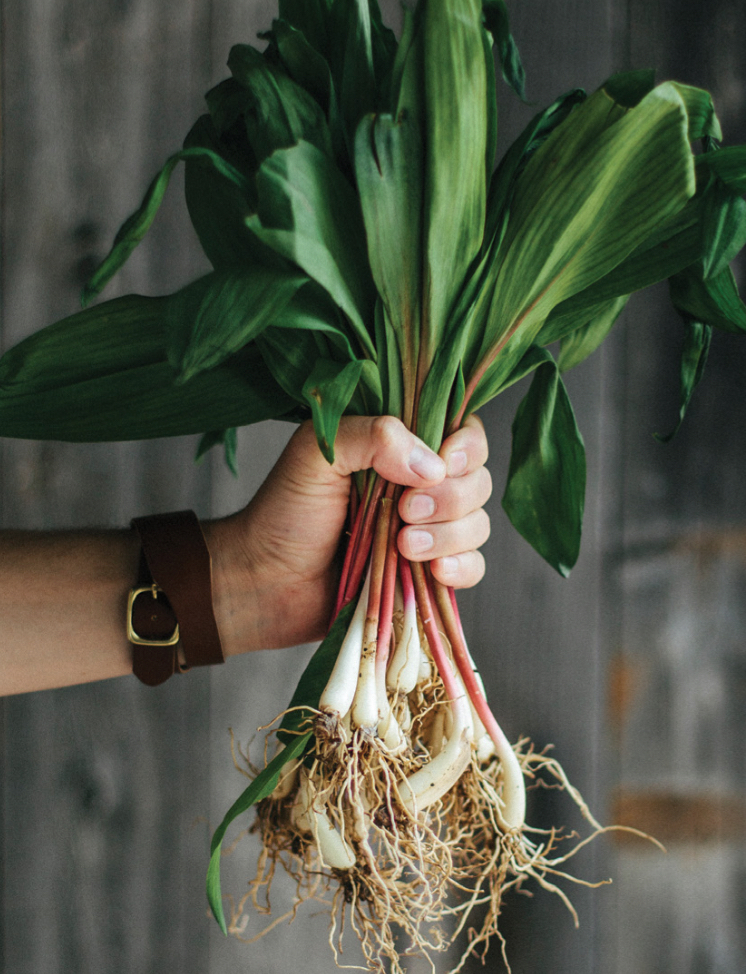
For the white asparagus
Trim away the woody ends and blanch the white asparagus in salted boiling water until cooked (three minutes). Transfer to an ice bath. Once cool, cut each piece into three small pieces (batons). Reserve for later.
For the ramp top puree
In a saute pan, add the diced shallot and one tablespoon (15 grams) of butter to hot pan. Sauté shallot until translucent. Add cleaned ramp tops and cook for five to seven minutes. Add cooked mixture to blender and puree on high for thirty seconds. Chill and reserve.
For the beurre monte
Add one tablespoon (15 milliliters) of water to saucier pot, heat, and slowly add the cubed butter. Whisk constantly until water and butter have emulsified. Season generously with salt and pepper. Reserve on a simmer.
For the egg yolk
Cook for one hour at 63.5º C (146º F) in a mixture of grapeseed and olive oil.
To Finish
Gently poach the cleaned morels in the beurre monte mixture for four
minutes. Wipe off any excess butter. Put on the plate.
Toss the white asparagus in a small amount of the warm beurre monte, and put on the plate.
Spoon the ramp top puree alongside the morels and white asparagus.
Place the Delice De Bourgogne on the plate.
Add warm egg yolk, sliced radish, dandelion greens, red orach, and purslane.
Recipe: Alpine Fizz
A gin cocktail with homemade huckleberry-sage syrup
Ingredients
- 1½ ounces (44 milliliters) CapRock Gin
- ½ ounce (15 milliliters) Braulio
- ½ ounce (15 milliliters) huckleberry-sage syrup *(see additional recipe)
- ¾ ounce (22 milliliters) lemon juice
- 1 egg white
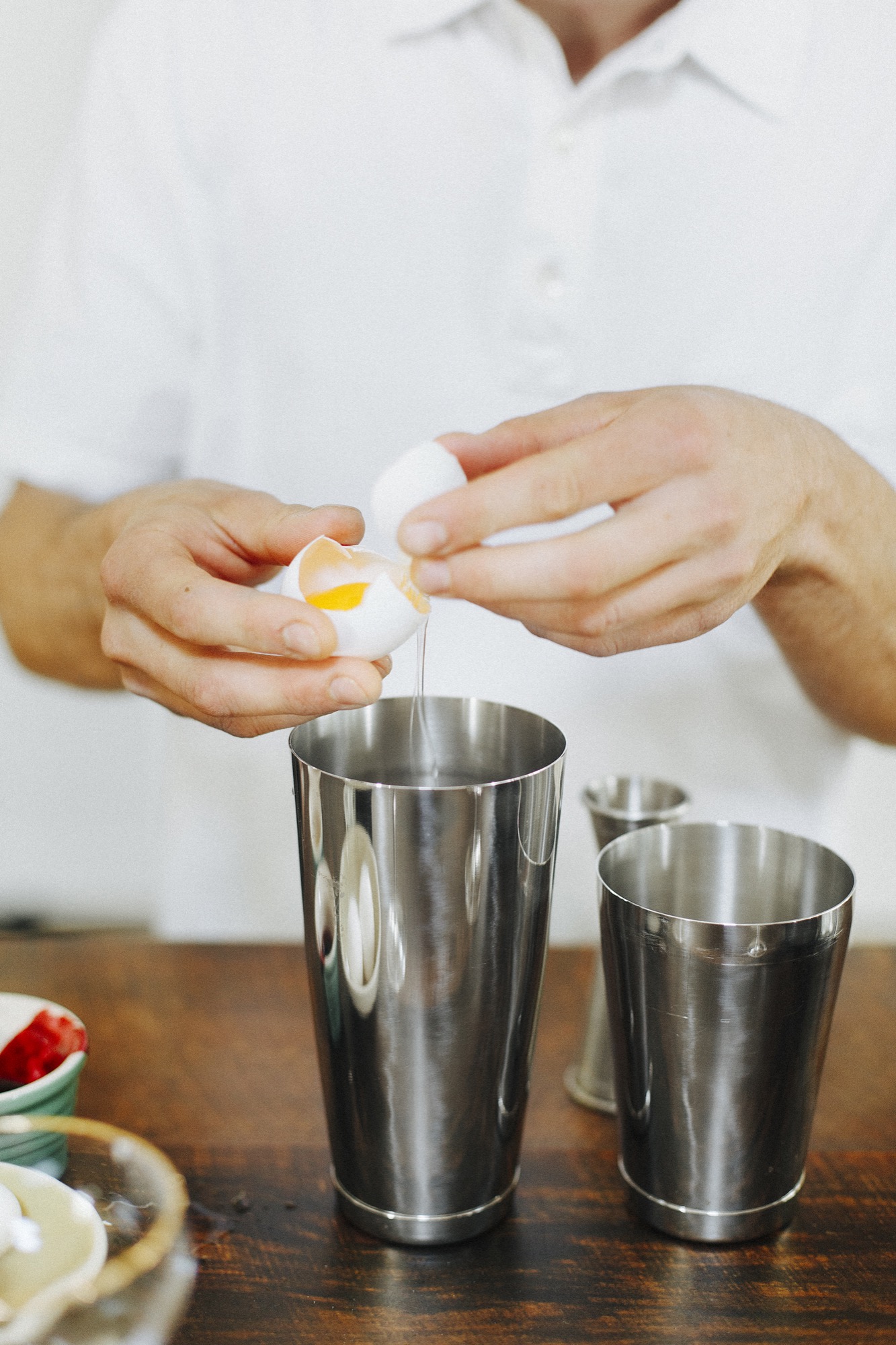
Combine all ingredients in a shaker tin.
Dry shake ingredients without ice to aerate egg white.
Shake ingredients with ice to chill and dilute.
Using a hawthorne and a ne strainer, strain cocktail into a chilled coupe.
Garnish with fresh herbs and/or huckleberries.
For the huckleberry-sage syrup
Combine equal parts huckleberries and granulated sugar into a sauce pot.
Bring to a boil and simmer just until the huckleberries begin to burst.
Add sage leaves and continue to simmer gently.
Once infused, remove sage leaves and discard.
Place syrup into a blender and blend until smooth.
Strain syrup with a strainer and refrigerate until cool.
Final product should be thick but pourable, adjust with water if necessary.
Recipe: Smoked Trout Salad
Home-smoked fish alongside woodsy fiddlehead ferns
Ingredients
- 1 cup (236.5 grams) salt
- ⅓ cup (71 grams) sugar
- 8 ounces (227 grams) emmer wheat (farro)
- 1 lemon
- 1 bunch parsley
- Fresh cherry tomatoes
- Chives
- Sherry vinegar
- 8 fiddlehead ferns
- 6 ounces (170 grams) fresh cheese (burrata)
- Dandelion greens
- Chickweed
- Red ribbon sorrel
- Wild wood sorrel
- Yarrow
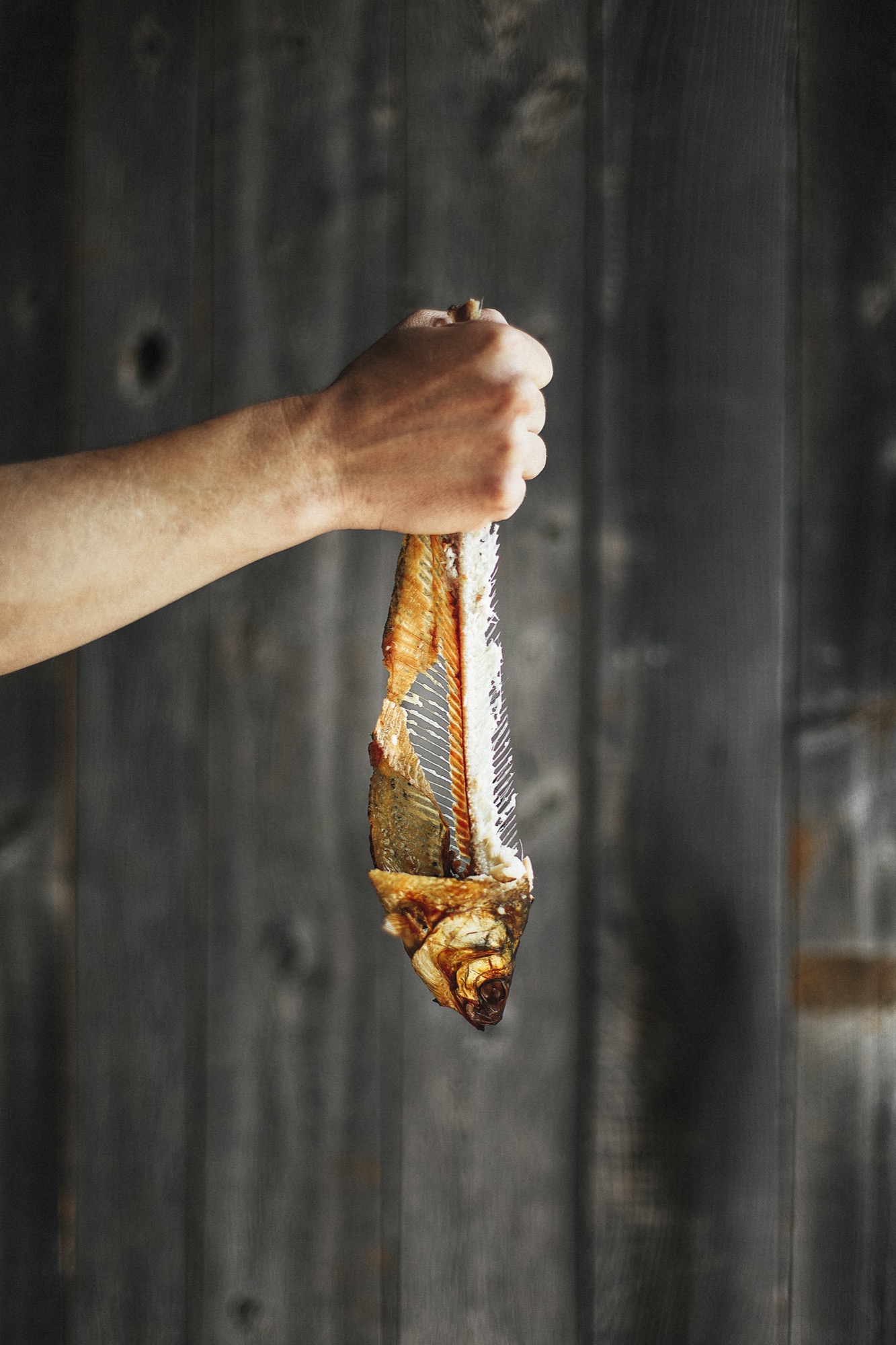
For the smoked trout
Combine one cup salt (236.5 grams) and one-third cup (71 grams) sugar and sprinkle evenly over the small filleted fish. Refrigerate for eight hours to cure. Remove from fridge and rinse under cold water. Refrigerate the fish overnight, uncovered. In the morning, light the charcoal grill (preferably using applewood and charcoal). Once the coals are hot, push them to one side of the grill. Place a tray with ice next to the coals. Put the grill grate on top of the charcoal and the tray of ice. Set the trout on a metal baking pan directly above the tray of ice and “smoke” the trout for ten minutes.
For the farro
Put the farro in a pot and fill with cold, salted water until the farro is submerged. Bring to a boil and simmer. Cook for fifteen minutes until the farro is tender. Strain. Season generously with lemon juice, sherry vinegar, salt, and pepper. Add sliced tomatoes, sliced chives, and parsley.
For the fiddlehead ferns
Remove the top portion of the stems and blanch in a large pot of salted, boiling water for a eight to ten minutes, until tender. Place in a small ice bath to stop the cooking process.
To finish
Spoon the nished farro onto the plate.
Add the smoked trout on top.
Garnish by adding the fresh farm cheese, seasoned fiddlehead ferns, dandelion greens, chickweed, sorrels, and yarrow.
Drizzle with Extra Virgin Olive Oil.
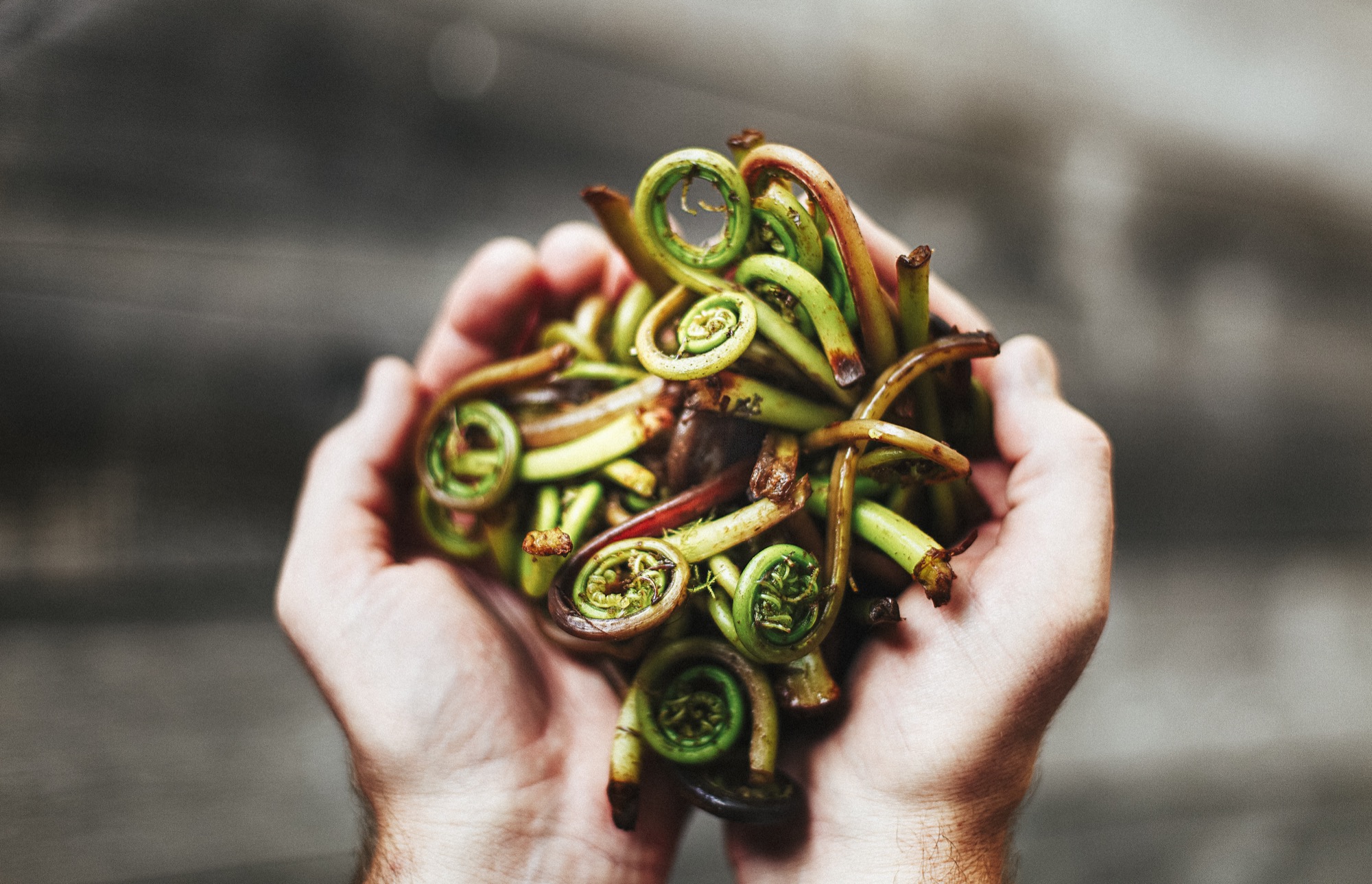
Alpine Modern Chef Colin Kirby on fiddlehead ferns:
The ingredients featured in these pages make all the difference. Wild, fresh, and foraged flavors have become a staple in the culinary world, and this dish reflects that point. A main component to the smoked trout dish is the fiddlehead fern. The ferns have a great woodsy, almost bitter flavor reminiscent of where they came from: the forest floor. Their texture is superb, providing an added bite to the creaminess of the trout and fresh cheese. Technically, they are the furled fronds of ferns. They are incredibly healthful as well, high in fatty acids. Fiddlehead ferns can also be pickled and eaten anytime.






